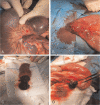Appendiceal carcinoid in a pediatric patient with Peutz-Jeghers syndrome: A case report and comprehensive literature review
- PMID: 34596162
- PMCID: PMC8483869
- DOI: 10.1097/MD.0000000000027389
Appendiceal carcinoid in a pediatric patient with Peutz-Jeghers syndrome: A case report and comprehensive literature review
Abstract
Rationale: Peutz-Jeghers syndrome (PJS), a rare autosomal dominant disorder, is characterized by mucocutaneous pigmentations, hamartomatous polyps in the gastrointestinal tract, and a high risk of developing various malignancies. To the best of our knowledge, only 1 case of appendiceal carcinoid associated with PJS has been previously reported in the pediatric population.
Patient concerns: We report a 7-year-old girl who was admitted for severe, intermittent abdominal pain and cramps, nausea, and vomiting. Multiple brown melanotic macules on the lips, buccal mucosa, and the tongue were noted.
Diagnosis: A plain abdominal X-ray in a standing position revealed dilated intestinal loops with multiple air-fluid levels. A computed tomography scan of the abdomen showing a "coffee bean" appearance of the jejunal loop with a transition point to the duodenal loop. Axial-contrast-enhanced computed tomography scan of the abdomen showing dilated jejunum loops, filled with fluid with the swirled appearance of mesentery typical for volvulus. The diagnosis of PJS was based on clinical findings along with the histopathologic confirmation of the hamartomatous polyps.
Interventions: An emergency laparotomy was performed, revealing a jejunojejunal intussusception starting 40 cm from the duodenojejunal flexure. Jejunotomy revealed that a lead-point intussusception was a necrotic hamartomatous polyp. After resecting the involved jejunal necrotic segment, including the polyp, end-to-end jejuno-jejunal anastomosis was performed. Further exploration revealed the presence of a jejunal mass 80 cm from the duodenojejunal flexure identified as another hamartomatous pedunculated polyp. The polyp was resected, and the enterotomy was then closed transversely. The grossly normal appendix was also removed.
Outcomes: Clinical findings along with the histopathologically confirmed hamartomatous polyps were consistent with PJS. An appendiceal carcinoid (well-differentiated neuroendocrine tumor, European Neuroendocrine Tumor Society stage pT2) was incidentally detected during histological examination of the appendix. The patient and parents were counseled accordingly, focusing on active surveillance and control of symptoms. Two additional hamartomatous polyps (gastric and jejunal) were detected endoscopically and resected in the fourth postoperative week. A regular, 1-year follow-up and surveillance revealed no complications or recurrences.
Lessons: Unusual neoplasms can occasionally be encountered in well-defined syndromes such as PJS. Therefore, active follow-up and surveillance are mandatory for all patients with PJS.
Copyright © 2021 the Author(s). Published by Wolters Kluwer Health, Inc.
Conflict of interest statement
The authors have no conflicts of interest to disclose.
Figures




Similar articles
-
A rare cause of mechanical intestinal obstruction due to small bowel intussusception: 'A solitary Peutz-Jeghers type hamartomatous polyp'.Ulus Travma Acil Cerrahi Derg. 2022 Jun;28(6):879-883. doi: 10.14744/tjtes.2021.34560. Ulus Travma Acil Cerrahi Derg. 2022. PMID: 35652870 Free PMC article.
-
Peutz-Jeghers syndrome in women with jejunojejunal intussusception and multiple gastrointestinal polyposis: A case report.Int J Surg Case Rep. 2025 Jan;126:110713. doi: 10.1016/j.ijscr.2024.110713. Epub 2024 Dec 1. Int J Surg Case Rep. 2025. PMID: 39626430 Free PMC article.
-
An incidentally discovered asymptomatic para-aortic paraganglioma with Peutz-Jeghers syndrome.Saudi J Gastroenterol. 2012 Nov-Dec;18(6):388-91. doi: 10.4103/1319-3767.103432. Saudi J Gastroenterol. 2012. PMID: 23150026 Free PMC article.
-
Peutz-Jeghers syndrome with intermittent upper intestinal obstruction: A case report and review of the literature.Medicine (Baltimore). 2017 Apr;96(17):e6538. doi: 10.1097/MD.0000000000006538. Medicine (Baltimore). 2017. PMID: 28445255 Free PMC article. Review.
-
Extremely young case of small bowel intussusception due to Peutz-Jeghers syndrome with nonsense mutation of STK11.Clin J Gastroenterol. 2019 Oct;12(5):429-433. doi: 10.1007/s12328-019-00964-0. Epub 2019 Mar 19. Clin J Gastroenterol. 2019. PMID: 30888642 Review.
Cited by
-
[Current research status of Peutz-Jeghers syndrome in children].Zhongguo Dang Dai Er Ke Za Zhi. 2024 Oct 15;26(10):1122-1126. doi: 10.7499/j.issn.1008-8830.2404054. Zhongguo Dang Dai Er Ke Za Zhi. 2024. PMID: 39467684 Free PMC article. Review. Chinese.
References
-
- Daniell J, Plazzer JP, Perera A, Macrae F. An exploration of genotype-phenotype link between Peutz-Jeghers syndrome and STK11: a review. Fam Cancer 2018;17:421–7. - PubMed
-
- Beggs AD, Latchford AR, Vasen HF, et al. . Peutz-Jeghers syndrome: a systematic review and recommendations for management. Gut 2010;59:975–86. - PubMed
-
- Giardiello FM, Trimbath JD. Peutz-Jeghers syndrome and management recommendations. Clin Gastroenterol Hepatol 2006;4:408–15. - PubMed
-
- Riegert-Johnson DL, Westra W, Roberts M. High cancer risk and increased mortality in patients with Peutz-Jeghers syndrome. Gut 2012;61:322.author reply 322-323. - PubMed
Publication types
MeSH terms
Supplementary concepts
LinkOut - more resources
Full Text Sources
Medical

